The Power Meters Buyer’s Guide–2014 Edition
[Please see my 2016 Edition of the Power Meter Buyers Guide Located here.]
How quickly a year has gone by since my last power meter buyers guide. In that time we’ve seen an explosion of new entrants into the power meter industry, some even actually coming to market with products you can walk into a store a buy. So with all of the announcements for this year taken care of, it’s time to lay out my thoughts and look at all the options.
If there’s anything I want to change in the industry it’s the mindset that there is a single perfect power meter for every consumer. Thus, if you ask someone for “the best power meter”, and they give you any answer other than “it depends”, don’t trust that person. That person should be asking you your specific use case, bike placement limitations, and how much you want to spend.
The cycling market has many unique use cases and thus you’ll need to take into consideration your specific requirements. For example, it’d be silly to go out and buy Garmin Vector if you’re looking to put it on a mountain bike. And similarly, it’d be silly to buy a PowerTap hub if you currently have HED H3 wheels.
Note that I’m not going to cover why you’d use a power meter here, nor how to use it. For those, start here with these posts. Instead, I’m just going to focus on the products out in the market today, and those coming down the road.
Finally, remember that power meters tend to be about as fiery as politics and religion. So keep in mind this is just my view. There are certainly other views out there (all wrong of course), but this comes from my perspective of trying out all the products below and hearing feedback from literally hundreds of people per day. There are no doubt edge cases I can’t easily cover in a single readable post, but I think I’ll cover 99% of the people out there. The remaining 1% can consider a donation of gold and/or expensive rocks for my further thoughts.
With that, let’s dive into things.
Power Meter Placement:
Before we start diving into the brands, features and functionality, we should probably talk about placement. The reason being that unlike a bike computer that works on just about every bike on the planet, power meters actually have more limitations than you might think. Some limitations are straight technical (i.e. it won’t fit), and some are preference based (i.e. I don’t like it). In either case, for most people this section will help narrow down the selection a bit.
Let’s just briefly ensure we’ve got everyone on the same page as far as where these things all go, starting with the below photo and using the text after it as a guide.
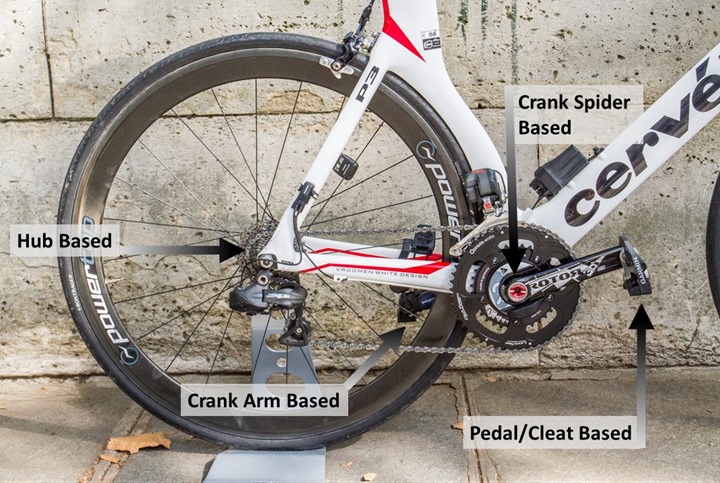
As you can see above, we’ve got four main areas we see power meters placed today:
1) Rear wheel
2) Crank spider
3) Crank arms
4) Pedals/Cleats
There are tangential products on other areas of the bike, but none of those currently on the market actually have strain gauges in them. Thus they are more estimations (albeit occasionally highly accurate) than actual force measurement devices. Nonetheless, for the purpose of this post I’m sticking with products I’d actually recommend, versus ones I’m hesitant to recommend. Or put more technically: I’m keeping the focus on what’s known as “direct force power meters” – which are units that measure force via a strain gauge of some sort. And finally, I’m not going to talk about companies that have gone out of business (i.e. Ergomo), or products that haven’t been made in a long while (i.e. Polar chain power meter). Not that I’d recommend either anyway at this point.
Back to my photo-diagram, I want to expand out the crank area a bit and talk specifically to that. Here’s a quick cheat-sheet of which products are where:
Rear Wheel: PowerTap hubs
Crank Spider: Quarq/SRAM, Power2Max, SRM
Crank Arms: Rotor, Stages, Pioneer, 4iiii, Watteam
Pedals: Garmin, Polar/Look, Xpedo
Cleats: Brim Brothers
There are three power meter types currently within the crank spider location: SRM, Power2Max and Quarq. The crank-arms themselves include Stages, Pioneer, and Rotor. And finally, at the pedals you currently have Garmin Vector, Polar/Look , Brim Brothers (not on market yet), and Xpedo (not on market yet). In the case of left-only variants of some of those products (Polar/ROTOR/Garmin), it’s still the same placement, just on the left side instead of both sides.
Features and Functionality:

Now that we’ve covered where each unit goes, let’s talk about the features that the power meters on the market have today:
Total Power (Watts): This is the obvious one – every power meter has this today (even estimated ones!). This is simply measuring and transmitting your total power output to a head unit of some type.
ANT+ Support: Another relatively obvious one, the vast majority of power meters on the market today transmit via ANT+ to compatible had units. This allows you to use one of dozens of different head units out there. I’d be very hesitant to choose a non-ANT+ power meter unless you already know which head unit you’re going to pair to it (for example, the Polar V800 or Ambit3).
Bluetooth Smart: Bluetooth Smart (or BLE/BTLE for short) is the relative newcomer in the power meter market. Right now there’s three units actively on the market with Bluetooth Smart support: Stages, PowerTap, and Polar/Look (in a few weeks). Some units on the market offer dual ANT+/Bluetooth Smart support (Stages), while others are dedicated (Polar/Look), and others yet offer swappable caps (PowerTap). I’m a huge fan of what Stages did by going dual as it allows you to buy whatever head unit you’d like on either side of the fence.
Left Only Power Meters: These power meters only measure power from the left side. All of these units then simply double the left power and produce total power. Stages really exploded this category with their left-only power meter, and other vendors followed suit including Garmin (Vector S), Rotor (Rotor LT), and Polar (Keo Power Essential). Additionally, some companies are looking at offering a single pod/solution for one side, such as 4iiii.
Estimated Left/Right Power: This became all the rage just prior to true left/right units coming out, starting with the SRAM/Quarq RED unit offering left/right power. That platform works by essentially splitting your crank in half and assuming that any power recorded while pulling up is actually coming from the left side, whereas pushing down is from the right side. Thus, an estimation. It’s good, but not perfect. Note that even with true left/right power (below), there’s actually very little in the scientific community around what to do with the data. While you may think that perfect balance would be ideal – that hasn’t been established. And some that have looked into it have found that trying to achieve balance actually lowers your overall output. The only thing folks agree on is that measuring left/right power can be useful for those recovering from single-leg injury. Power2Max and all SRAM/Quarq models currently on the market use this method.
Actual or True Left/Right Power: This is limited to units that can measure your power in more than one location. Thus why we see it on pedals, as well as the more expensive crank-arm based power meters. You can’t measure it directly at the spider, instead you have to measure it upstream of that such as the cranks (ROTOR, Infocrank, Pioneer, Watteam, 4iiii), pedals (Garmin, Polar, Xpedo), or cleats (Brim Brothers)
Pedal Smoothness & Torque Efficiency: These two metrics are available in the high-end power meters which contain true left/right power measurement as well as a support head unit (some Garmin units, and Navi2Coach).
Cycling Dynamics: This is Garmin’s recently released suite of Garmin Vector specific features that enable data such as platform offset and where in the stroke your power is coming from (power phase), as well as seated and standing position. At this point this isn’t yet available even on Garmin products (coming later this year), so it’s a bit too early for me to make too many judgments. That said, I certainly wouldn’t let it be a major factor in purchasing. Polar also has a subset variant of this within their V650 and V800 coming with their Bluetooth Smart Polar/Look pedals next month.
Battery Swapping: All but one unit on the market today (SRM) supports battery swapping by yourself. SRM requires you to send it in (but gets way longer battery life in between swaps). The remainder of the units out there today utilize a CR2032 and similar coin-cell batteries. Most get between 200 and 400 hours of run-time before you simply replace the battery. Brim Brothers uses a rechargeable pod that gets about 16 hours of battery life.
Calibration options: All units on the market today support some sort of calibration function, though to what extent is what differs. Some have numerous options (i.e. Quarq with an app allowing you much further access), while others are more black-box (i.e. Stages and Polar). For the most part, your primary concern here is really that some sort of calibration occurs, and that you can trigger it to happen on demand. Beyond that it tends to get to more advanced calibration and torque checking methods. It should be noted that the term calibration can have very specific meanings to different people (technically most people are really doing a zero-offset). But for today’s post I’m going to keep it a bit more generic.
Ok, with all the core power meter features covered, let’s dive into the brands available today.
The On-Market Contenders:
We’ll start with products that you can effectively take home today. They’re in the market, available today for purchase and you can more or less install them today on the bike. For the purposes of this section I’m focusing on direct force power meters (DFPM’s), in a later section I’ll cover non-DFPM’s.
Additionally, in the following section after this I’ll cover announced but not yet available units that are on the road to market.
PowerTap:
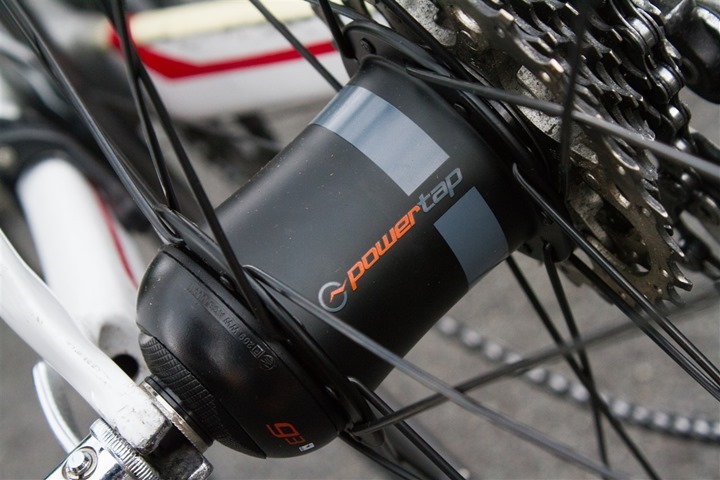
PowerTap has been around 15 years – longer than most folks realize actually. Though their popularity has really grown in the past few years, especially in the US. The PowerTap replaces your rear wheel hub, which means that it’s tied into a single wheel. This makes it easy to move between bikes, but also makes it difficult if you have separate training and racing wheels – ultimately costing one of those two situations to lose out on power. That said, this past year at Eurobike they seemed to hint at upcoming products in new form factors likely outside the rear hub.
From a cost standpoint their price cuts last year alongside Stages have pretty significantly changed the power market landscape. The reason it matters is it has brought down direct force power to sub-$800 for a new ANT+ enabled unit. While Stages does that (at $699), it has limitations around its left-only design (more on that later).
They’ve also introduced a Bluetooth Smart cap this past year, enabling you to relatively easily swap from ANT+ to Bluetooth Smart (or back) for about $120US. You can make the change back and forth at home in about 3-4 minutes (I just did it yesterday for a test ride).
Advantages: Easy install if you buy a wheel set with it pre-installed (my recommendation). Auto-zero while coasting helps keep things in check without you thinking about it. Manual calibration is easy, and swapping out batteries and the electronics pod quick and straight forward. Good customer service.
Disadvantages: Limited to a single wheel, so training vs racing scenarios can be tough. Also limited on things like disc wheels. And if you have multiple bike types where the wheel type changes (i.e. going from triathlon to cross), you may be in the same pickle there.
Would I buy it: Absolutely, and in fact, it’s one of the units that I’ve bought myself as a workhorse in my power meter testing. Based on what I’ve seen, the PowerTap is the closest I get to ‘set it and forget it’ when it comes to power meters on the market today (talking specifically to calibration/offset variance and stability). However, if you’re one that changes wheel sets frequently in your training, I’d be more measured in deciding whether it’s worth not having power somewhere (I don’t think it is). Though, with their recent price cuts, it makes buying two PowerTap’s basically as cheap as buying a single crank-based unit.
Relevant Posts: CycleOps Joule and PowerTap Wheelset In-Depth Review, PowerTap’s new hubs, Bluetooth Smart Trainers, iPad apps, and more, PowerTap gives sneak peek at new product development, and other updates from the company
(Note: CycleOps has renamed its power meter organization to simply be “PowerTap”, and prefers that the company thus be called “PowerTap”. Thus, I’m using that naming.)
Power2Max:
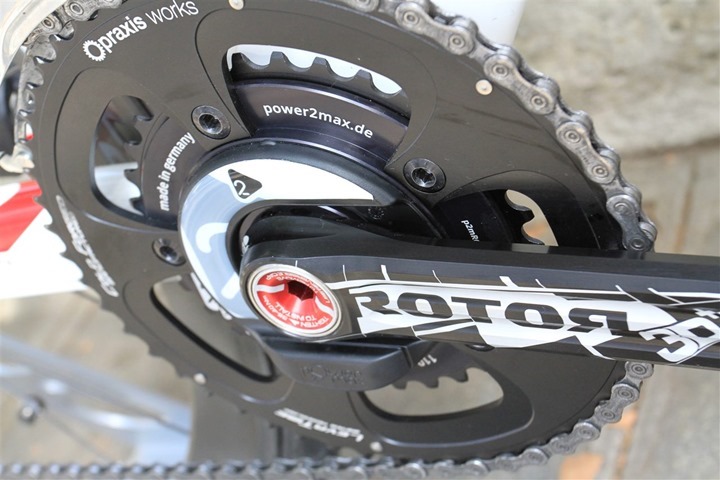
Power2Max has been on the scene for roughly a little over 3 years now. With the addition of their second generation Type-S units last fall (3rd generation units), they further expanded their lineup You’ll remember from the review I did two winters ago that I saw no major issues with the 2nd generation units. I now have their latest 3rd generation units (the Type-S) on my bike now in testing. So far, so good.
The units are typically sold with or without cranks, so you’ll need to add your own, or purchase them from Power2Max pre-installed. For the crank-less price (roughly under $1,000US ), they are a very solid option. They do still have some limitations on crank set compatibility, but they continue to expand into new crank choices, as recently as Eurobike’s announcements a couple weeks ago.
When I use the Power2Max (like Quarq and PowerTap), I find them among the least finicky and most ‘easy to use’. Day in and day out in testing these units tend to ‘just work’ for me with very little calibration worries.
Advantages: The least expensive crank-based solution on the market today. Good accuracy with a growing crank set compatibility matrix. Temperature compensation has definitely helped any initial teething pains on v1 units.
Disadvantages: There isn’t a method to turn off auto-zero today on units (which is really only an issue for the most advanced of advanced users).
Would I buy it: I wouldn’t have any problems purchasing a Power2Max unit. I love that they’re well into the ‘just works’ category. I installed one this past week on my bike in record time and had it worked beautifully on the first ride – aligning spot-on with my other power meters.
Relevant Posts: Power2Max Power Meter In-Depth Review, Power2Max releases new Type S line, expands compatibility, Power2Max introduces Type S mountain bike power meter, additional road bike models
Garmin Vector:
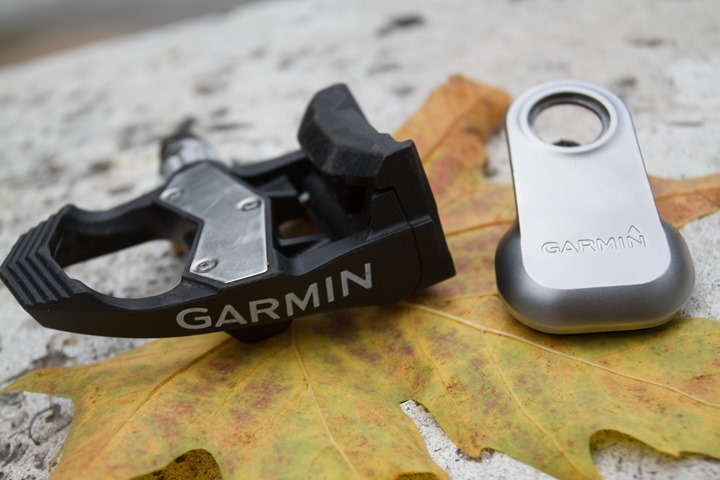
Next is Garmin Vector, it’s been out in the wild just over a year now. The dual pedal system measures left/right power separately, as well as measures other metrics like torque effectiveness and smoothness, as well as soon Garmin’s Cycling Dynamics (such as seated/sitting time).
Over the past year, it’s been interesting watching the evolution of the product. They’ve made a number of hardware and software changes. For example, to minimize pedal pod breakage during install they changed the material (and they’ve swapped anyone’s pods out that breaks for free). Additional software updates coming shortly should reduce some of the calibration steps, as well as a few tiny changes in hardware to minimize cartridge issues seen by a few folks. Accuracy-wise, the unit seems on par with any other power meter once properly installed. That proper installation requires a torque wrench (most power meters actually specify one), as well as a specialty crowfoot adapter. While that adapter has been very hard to find, it’s now being included in the box of all Garmin units.
As noted, at present the only pedal type supported is the current model. While it sounds like longer term they’ll look at other pedal types, I don’t expect that to happen anytime soon. Instead, I suspect you’ll see them continue to tweak the existing platform via software updates primarily.
Finally, Garmin has released their new Vector S solution, which is simply the left-pedal side of the platform. It costs about $200 more than Stages, which, depending on what your use case is may be a better option (if you have carbon cranks), or a less appealing option (if you use a different pedal type).
Advantages: Portability between different bikes. Least expensive true Left/right power meter on the market/available today with potential for more advanced fit-type metrics down the road via firmware updates, like the upcoming Cycling Dynamics
Disadvantages: The biggest drawback right now is pedal choice (just Look-compatible), and then following closely behind that is crank arm choice is limiting due to some widths. Portability isn’t quite what it seems if you travel (you’ll need a torque wrench to really install properly), but within your house it’s really straightforward.
Would I buy it: Yes, I own two sets now that I use in power meter testing with a slew of other products. Again, assuming you spend the 3-5 minutes to install it properly, it’ll give you quite accurate numbers. Now, that said, I’d be looking very closely at some of the options in the ‘Upcoming’ section down below. If those end up releasing as accurate as Vector, then Vector will be much less appealing at its current price point.
Relevant Post: Garmin Vector In-Depth Review , Garmin announces Vector S: $899 power meter, also announces Cycling Dynamics
Polar/Look:
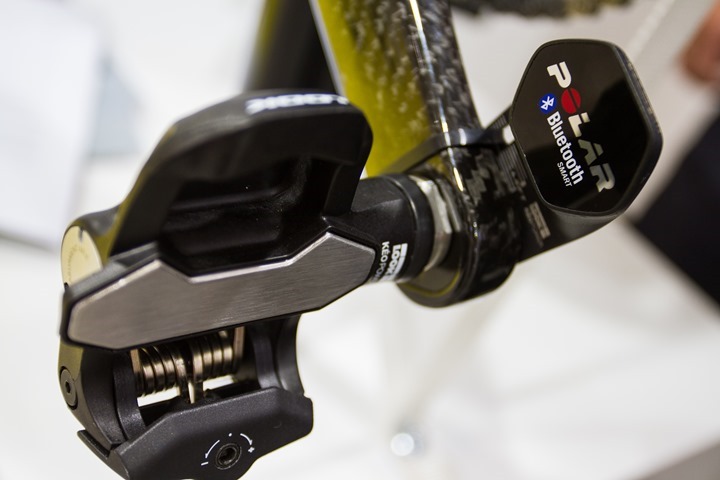
The Polar/Look Power System pedals are almost three years old at this point, but are about to undergo a significant shift being Bluetooth Smart enabled starting in a few weeks. This will dramatically shift the usefulness of the existing product from being kinda useless due to lack of support in head units, to being highly useful with Bluetooth Smart and support for it in the Polar V800 and V650. They’re also changing much of the calibration aspects of the system to make it far easier (and more accurate) to use day to day. From a functional standpoint the pedals appeared to work fairly well in my tests, and did correlate fairly well with other power meters.
At this point I’m putting this mostly in the ‘let’s see how things end up’ with Bluetooth Smart. I certainly would never buy the W.I.N.D. version at this point, but, I think the BLE version could be very interesting in the coming months. I’ll be testing that variant alongside the Polar V650, so expect some form of double-review once those products hit availability.
Finally, Polar announced a new version this past summer, Keo Power Essential, which is a left-only option. In this scenario you just get the left pod and pedal, and then it doubles the power for the right side. This has the same inherent limitations as Stages, but also offers a lower price point than the full Keo dual-pedal system.
Advantages: Pedal based means theoretical portability, system largely ‘just works’ once you get it installed. Appears accurate, but really hard to validate all aspects (i.e. left/right). Very few options for configuration means less to mess up.
Disadvantages: Installation is a bit complex. Not as easy as Vector to move between bikes. Limitations on crank widths/lengths. For the older W.I.N.D. version, worse cycling head unit on the market. For the upcoming Bluetooth Smart version though, it should be less of an issue due to broad planned compatibility with 3rd parties as well as Polar products.
Would I buy it: I’m putting this on the ‘hold’ list. Let’s see how the Bluetooth Smart update (and corresponding hardware tweaks) work out. If it produces clean and accurate power, and if the head unit compatibility is broad, then this might definitely be an option. Until then…hang tight! Finally, as for the one-crank version (Keo Power Essential), that’s a bit tougher given that Stages is cheaper and generally speaking easier to move between bikes (and has dual ANT+/BLE instead of just BLE).
(Update Dec 5th, 2014: Polar has just recently released the pedals, however, the V650 head unit hasn’t yet been released yet. From a review standpoint, I had planned to somewhat do both at once. Given the V650 is now in Q1, I’ll likely be timing both the BLE Pedals as well as V650 review to that time frame. Thanks!)
Relevant Review: Polar Look Keo Power System–Pedal Based Power Meter–In-Depth Review, Polar announces new Keo Power systems, and V800/V650 power meter update plans, and more!
Quarq Riken/ELSA/RED:
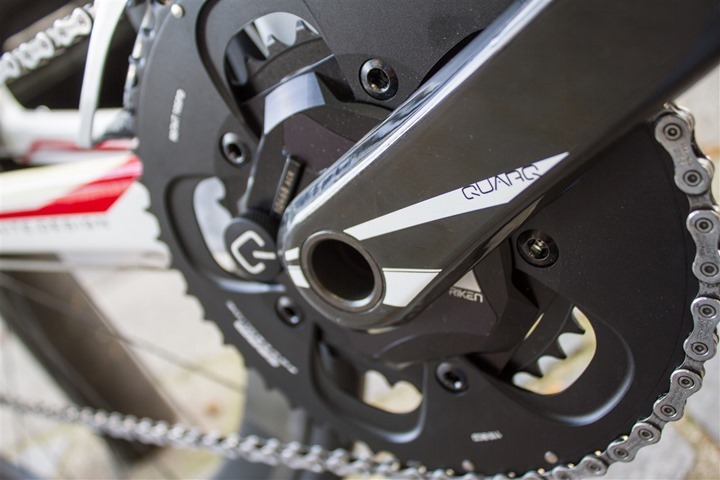
Quarq became the first non-SRM crank-based power meter that was actually affordable. Starting off on straight road bikes they’ve expanded to other areas including track and cross bikes. The unit replaces your existing crank spider and depending on the model is typically sold with specific crank arms attached. You’ll need to ensure your bottom bracket is compatible, but if you shoot the Quarq folks an e-mail I’ve found they can usually help anyone figure that out easily. All Quarq power meters are made in South Dakota (US), along with servicing and shipping from there.
The Quarq Cinqo was actually the first power meter I bought, and what The Girl subsequently purchased as well for her training. I’d been using it without issues for 5 years up until this fall when it appears some water ingest got in the the unit causing it some problems. Quarq’s been known for their customer service (overnight return shipments and the like), and swapped out my older Cinqo for the current Riken (I confirmed that’s their normal replacement policy for out of production units). Looking at service feedback I see from others, I continue to hear nothing but good things.
Quarq was the first unit to estimate power left/right based on which portion of the stroke you were in. Since then they introduced their ELSA unit, which also includes the same technology. RIKEN was also introduced at the same time as a replacement for the older generation Cinqo units. While RIKEN doesn’t have left/right power, they did gain the ability to swap chainrings without sending it back to the factory.
Comparing ELSA to the less expensive PowerTap makes it slightly difficult to justify the Quarq ELSA/RED prices, given PowerTap is literally half the price for the same accuracy. Obviously, there are placement differences however. However, the RIKEN pricing is much better at $1,200US (without chainrings), and really the only tangible difference for most will be the lack of estimated left/right power. Given it’s estimated, and given there’s not a lot to do with left/right power yet, I think this is a very solid option.
Advantages: Crank-based design means no wheel swap issues. Accuracy on-par with other units. Can swap chain rings without issue. Easy replacement of battery, and can utilize phone apps for further calibration. For me, it has a high ‘just works’ factor. Also, new firmware update removes need for magnet on bike.
Disadvantages: Crank arm selection has diminished some with SRAM acquisition (reducing compatibility), pricing may not be as competitive going into 2015.
Would I buy it: From the standpoint of “Have I bought it?”, the answer is obviously yes (Cinqo twice, Riken upgrade from Cinqo). From the technical standpoint, I have no issues with either the RIKEN or ELSA units, which I’ve done quite a bit of testing on. All of those units perform as expected technically. And obviously, customer service-wise they’re awesome. The challenge at present is really pricing and the competitive market, which I’ve touched on above.
Relevant Reviews: Quarq/SRAM RED Review, Quarq RIKEN In-Depth Review, Eurobike 2014 Power Meter Roundup: Quarq News
Stages Power:
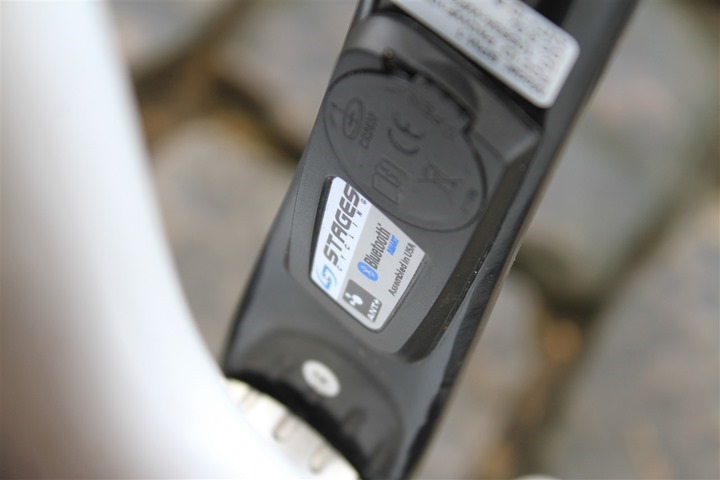
Stages has had a pretty big year this past 9 months or so, most notably with the sponsorship of Team Sky and their headlining athletes. Prior to that though, in 2013 they rolled out their $699 direct force power meter. While it had a bit of a rough start the first few months those issues were resolved and now they’ve been adding in new features and greatly expanding crank arm selection.
Stages is unique in that it’s attached to your left crank-arm (seen above), and thus is only measuring the left leg power. It simply doubles the left-leg power to get total power. This means if you vary, or vary in certain conditions then the power might not be accurate – or something that you could compare to years from now on different products.
On the technology front I LOVE their ANT+ and Bluetooth Smart dual broadcasting design. This is even better with Polar’s just rolled out firmware update for the V800, which supports Bluetooth Smart power meters like Stages, and it also works with Suunto’s Ambit3 triathlon watch.
Finally, on the pricing front the $699 pricing was incredibly attractive nine months ago. However today with the PowerTap pricing where it is, it may give some pause (since PowerTap doesn’t have left-side-only power issues). Adding to that the pressure soon coming from 4iiii, and we may see some shifts next year once 4iiii actually hits market.
Advantages: Least-expensive unit on the market today actually shipping. Easily moved from bike to bike with a simple Allen/hex wrench. Contains both Bluetooth Smart and ANT+ (and dual-broadcasts).
Disadvantages: Left-only approach means simply doubling left-leg power, may not be fully accurate representation of your power (high or lower). Not available on carbon crank arms.
Would I buy it: This is a much more complex question. Technically speaking it’s a well made unit that accurately measures the left side. From a pricing standpoint it’s tough to recommend the left-only approach with the PowerTap at just $100 more. If Stages were say $499 – then I think it’d be a much different discussion. Further, as I’ve collected a tremendous amount of power meter data over the past year with 3-5 power meters concurrently, I’ve started to understand my specific personal left/right balance biases. For most of my riding, there’d be no major issue with Stages. However for longer or higher intensity rides where I might fatigue more, I see some inaccuracies on Stages due to my personal leg differences. You might be the same, or you might be perfectly even. I don’t know.
I know it’s easy to point at Team Sky and simply say “It’s good enough for Froome and Wiggins”, but the reality is we’re talking about sponsored athletes and teams. In the case of Team Sky, for some riders that are/were seeing imbalance issues with Stages compared to SRM they simply have gone with a ‘known percentage offset’ for wattage goals. This is a bit of a throwing the baby out with the bathwater approach though, that numerous folks have proven isn’t terribly accurate. Which isn’t to take away from Team Sky and Stages, more power to them, but rather my point is that it’s not a one-size fits all implementation.
Relevant Review: Stages Power Meter In-Depth Review Update
SRM:
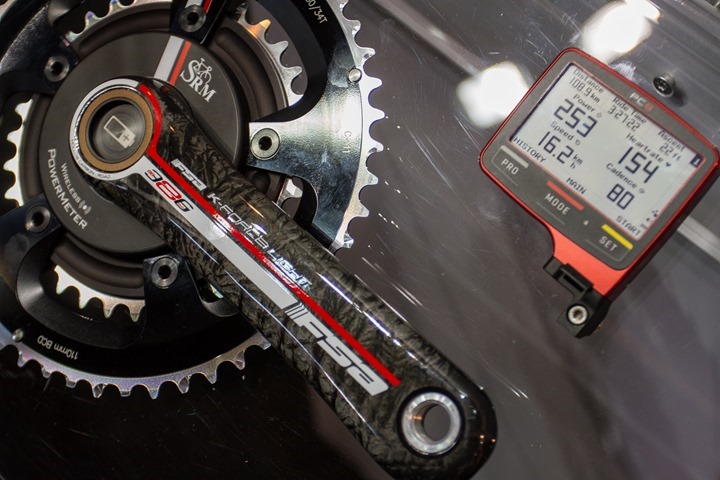
SRM has been around since the beginning of power meter measurement, and I don’t think there’s anyone that would argue that SRM doesn’t produce great products.
SRM’s strength has always been around data capture reliability, especially on the head units themselves. From a power meter standpoint however, they are really just as susceptible as any other power meter on the market to adverse events. Which, is probably an important point to note: No power meter out there today is perfect. Not even SRM. They all have conditions where they do really well, and conditions where they do less well. It’s understanding those conditions that’s most important. Which doesn’t take away from SRM, but rather simply serves to note that I believe there’s a bit of an urban legend with being the ‘gold standard’. Many of the products in this post can produce just as consistently accurate power as SRM (which again, SRM is good at doing).
While SRM and I have talked about doing a product review, I’m not sure there’s a substantial benefit in me doing one on older products. Perhaps if/when they release either a rechargeable unit with the PC8, or if/when they release a newer low-cost power meter that’s in the market.
Advantages: It’s a well established brand with a well understood product. The reliability is generally very good. With ANT+ you can use any head unit you’d like, and aren’t limited to just the SRM head units.
Disadvantages: Expensive. Servicing isn’t as open as other power meters on the market today. If looking at their head unit (not required), the current generation is simply really expensive for what you get.
Would I buy it: I don’t own one, and right now I simply have a hard time seeing the justification of the price over other units on the market today. With the exception of very specific technical use-cases that other power meters can’t fulfill, I feel that for 98% of the market today, there are more budget friendly options that are just as accurate. I don’t subscribe to the “gold-standard” concept, maybe at one historical point, but not in this market.
Relevant Post: First look at new SRM PC8 head unit with WiFi/GPS/ANT+ & Bluetooth, Eurobike 2014 Power Meter Roundup: SRM., Interbike 2014 SRM: Their iOS app, PC8, and their thoughts on low-cost power meters
Pioneer Power System:
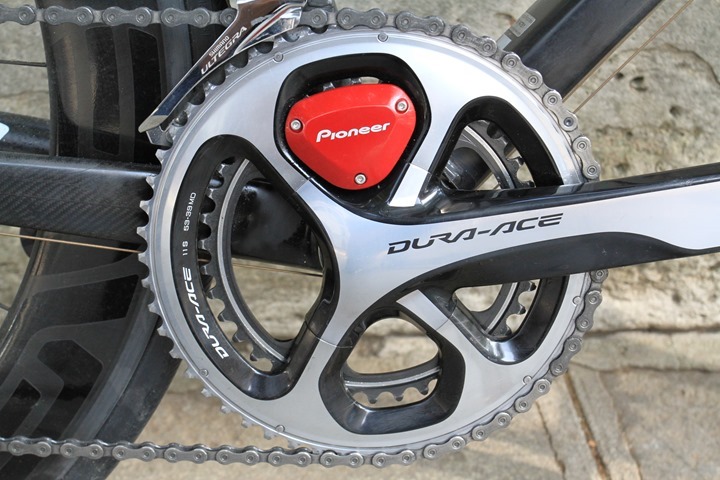
Pioneer has iterated nicely through two generations of power meters in the last year, roughly paced at one per year. In the process they’ve dropped the price by almost half, and then simplified install and purchasing. They also released a second edition of their head unit.
While I haven’t released my review of either edition, I have spent considerable time riding both editions. I do plan to release a review of the 2nd generation version (the 2nd gen version is red (pod color), versus black for the 1st generation – though me & Team Belkin had green caps)).
The Pioneer system is a bit different than most other power meters on the market in that you don’t do the install, rather, you get the kit sent to you fully installed. Additionally, it’s the only unit on the market with true left/right high speed data (starting at 12 samples per second (at 60RPM), faster the higher the cadence). While the 1st generation units received a bunch of undesireable attention due to ziptie usage, the 2nd generation units removed that requirement. It also removed the complex-crazy installation process.
Overall in my use I find it a perfectly functional power meter. The unit has two modes, one for ANT+ and one for private-ANT enabling the higher-analytic pieces noted above. It’s an either/or situation via a little switch in the battery compartment. To get that additional data you do need to use their head unit, which while strongly suited for its specific pairing to the power meter, is overall under-featured compared to something like a Garmin Edge 510. Thus, I’d largely recommend just focusing on the power meter itself unless you have a specific need for the higher end data.
Advantages: Has the highest recording rate of any power meter on the market today, measures left/right power and associated metrics more in-depth than anyone else. A completely pre-set system once it arrives to you. Any choice of chainrings you’d like on the planet.
Disadvantages: For crank arms, you’re limited to Ultegra and Dura-Ace Shimano cranks. For US folks, if you choose to use your own chainrings/cranks, there may be a delay of 7-10 days to send off to Pioneer (local shops can however stock the Pioneer system ready to go). Internationally however, the local shop will do it all in-house.
Would I buy it: I’d consider buying it without the head unit, but it’s tricky in that the limitations of crank/chainring choice are hard to get around. Price wise it’s positioned fairly well at the moment though for what you get.
Relevant Posts: No full in-depth review, but recent information here, and older information here. More newer information coming shortly.
Verve Infocrank
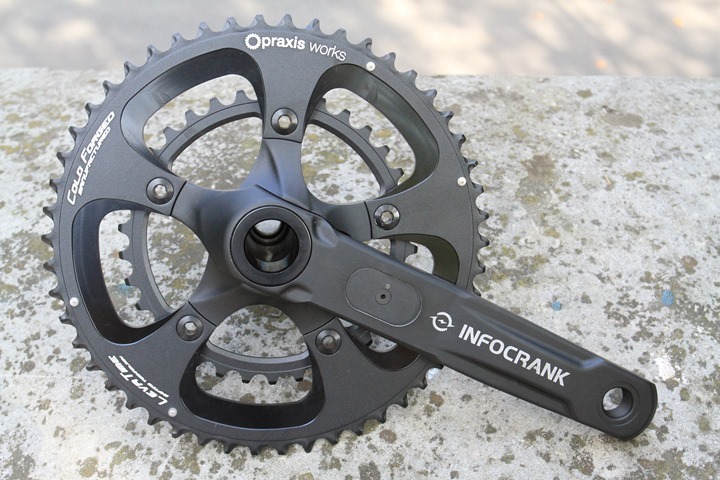
Verve is new on the scene over the past few months, and has introduced the Infocrank power meter. This dual crank-based power meter has strain gauges on both crank arms. Additionally of note is that the unit has custom designed crank arms that are specific to Infocrank.
The unit transmits on ANT+, and uses small coin cell-style batteries that you can go ahead and replace as required (no sending in needed). I’ve got a unit onhand, though ran into some bike compatibility snags during my first attempt. That said I just received some additional components that should enable it to get installed on my bike this week – so I’m looking forward to seeing how it handles.
Advantages: Claimed higher accuracy levels than the competition, complete end to end system that’s mostly ‘install and forget’.
Disadvantages: You’re very limited in crank compatibility (none) because everything is actually built into a custom crank arm. Thus, you do need to fully use their system.
Would I buy it: Honestly, I don’t know yet. Right now I’m slightly inclined to say it’s a bit pricey in the market compared to competitive offerings, but I’ll wait and see how it performs.
Relevant Posts: Eurobike Power Meter 2014 News Roundup: Verve Infocrank
ROTOR:
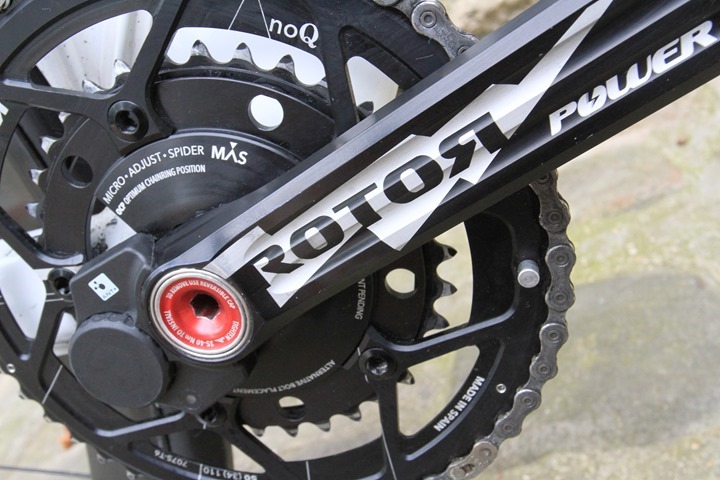
ROTOR announced their power meter two years ago at Eurobike, and started shipping about 18 months ago. The unit is designed to measure both left and right power separately – ultimately meaning you’ve basically got two power meters in a single unit. They were the first unit on the market to fully support the new ANT+ Torque Efficiency and Pedal Smoothness metrics – even before head units did. However, since then other units now have that same functionality.
From the start ROTOR had a number of issues with reliability and accuracy for many users. Software updates over the past year have addressed those for what I can tell are most users.
However, unfortunately, I am not one of those users. Despite having the unit on my bike for nearly a year (!), I can’t get accurate power out of it. I’ve had many discussions with ROTOR, swapped numerous data files back, and unfortunately haven’t gotten a clear explanation as to why I’m seeing what I’m seeing.
(For those curious, my specific problem is that I see an elevated right-crank arm value of about 5% or more, depending on the wattage. The easiest way for me to demonstrate this is with one-legged pedaling on a constant load and RPM (i.e. trainer) where the trainer’s load is maintained between switching legs. When I do so, I notice that while the left-leg always matches the total power produced by the trainer, the right leg will always be higher than the trainer power. Yet, other power meters on the bike at the same time show the correct/same total power as the trainer no matter which leg I use. No amount of calibration and offset tests, installs and re-installs, nor firmware updates has fixed this.)
While I would agree that others are probably using the system just fine and likely with accurate numbers, I simply can’t get those numbers. Ultimately I can neither recommend it nor not recommend it. From a testing cycle, I gave it every opportunity to work, and ultimately, I delayed numerous other products reviews to try and get it to work. I’m just going to be simple about it: I give up.
Advantages: Full left/right power, ability to track additional stroke/balance metrics, compatibility with ROTOR cranks and elliptical chainrings.
Disadvantages: Limited compatibility with crank sets, couldn’t get it to work myself. Expensive – $2,400US.
Would I buy it: At this point, it’s too early to say. Up until last week I would have said a resounding “no”, however their Software Update #8 sounds like it has addressed a number of major issues that were outstanding. I’d like to see how those results stand up to longer use, as well as my own testing later this fall.
Relevant Posts: First look at new ROTOR Power Meter, Eurobike Power Meter Update Post: Quarq, ROTOR, Pioneer, Brim Brothers & Ciclosport
Unreleased Products:
Next, we’ve got power meters that are currently in pending shipping state. This means that as a regular consumer as of the date of this publishing you can’t actually get your hands on one quite yet (though, some do offer pre-order options). Nonetheless, since I’ve been fortunate enough to actually ride all but one of these, I can offer a bit of perspective on them. Of course, until they do release a final product things could change. Ones that look promising could flop, and others that have challenges could be superstars. We just don’t now.
What we do know however is that nobody in the power meter market has actually hit their projected timelines for initial release of new products (I’m not counting minor variants). Seriously, nobody. Not SRM (new rechargeable model), not Garmin (Vector), nor Polar (Bluetooth edition). Despite what the interwebs would tell you – it’s rather difficult getting a mass produced accurate power meter, regardless of whether you’re a company with hundreds of millions in revenue (Garmin), or a startup (4iiii). Remember that it’s easy getting 95% there in power meter development, it’s the last 5% that can take years (and often does).
Nonetheless, here’s what’s in the pipeline. I’ve vaguely ordered them based on a combination of when the company says they’ll ship with when I think they’ll ship.
Brim Brothers Zone:
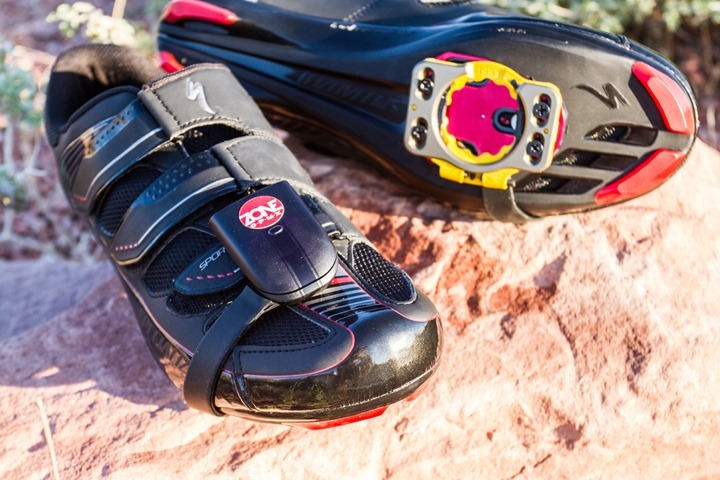
First up is Brim Brothers Zone, I recently previewed this a few weeks back at Interbike. The Zone system is cleat-based, and attaches to the base of your Speedplay compatible cycling shoes. This means that you can quickly move from bike to bike, as long as it’s Speedplay equipped. This is ideal for those with numerous bikes, or who travel and can control the pedal type.
Right now they’re planning to be out by the end of the year. While I ran into some snags during my test run, they plan to resolve those before shipping. At $999 for the pair of them (left/right), it’s no doubt likely to be a valid option going into next spring.
Related Posts: Brim Brothers announces Zone power meter production, my first ride impressions
4iiii Precision:
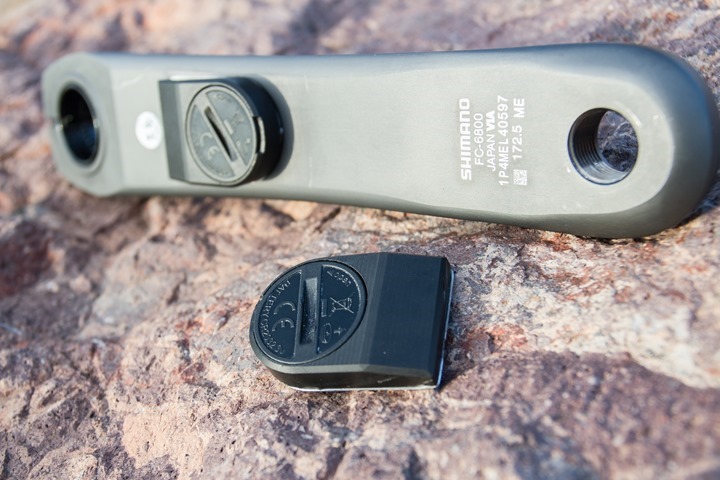
Next we’ve got 4iiii Precision. This solution is effectively like Stages, but with a DIY install option and dual-sided support. And it’s about half the price at $350-$400 per pod (depending on the pod). Additionally, they plan to offer carbon crank compatibility. Like Brim Brothers above, I tested this as well, and had quite good results for the early prototype unit I was using. Not perfect, but definitely very promising.
They’re aiming to be out by December, though, I think January/February might be more realistic. Still, they’ve got a great engineering team onboard and if you’re in the market for a power meter but don’t need one today (perhaps in a few months), then it may be worth waiting to see if things pan out.
Related posts: 4iiii’s Introduces $399 Power Meter, Precision: My First Ride With It
Watteam PowerBeat
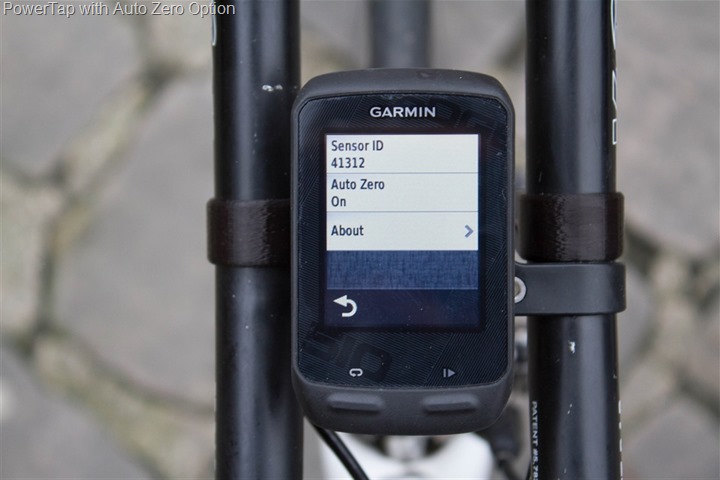
Watteam broke onto the market in early August with the announcement of a $499 left/right power meter system. The sensors attach individually to your left/right crank arms, and then have separate communication pods somewhat similar to Garmin Vector. The system is planned to work on both carbon and aluminum cranks, and is a bit less dependent on the flat surface of the back of the crank arm like 4iiii Precision.
Right now the company plans to hit the market by summer 2015. I had a chance to test out the platform a few weeks ago and the results while a bit early, certainly show some promise. Of course, given the timelines it’s a bit early to say how this specific story will turn out – but it’s something to keep an eye on going into late spring.
Related Posts: A chat with the CEO of Watteam and their new $499 power meter: PowerBeat, Watteam’s PowerBeat: A first look at prototype/beta power data
Xpedo Thrust E:
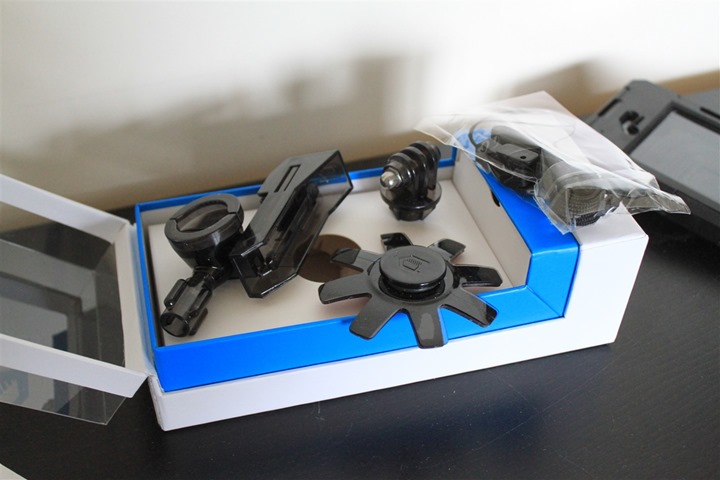
Next we have the perennial party crasher at bike events worldwide, the Xpedo Thrust E. This pedal based unit has been continually shown for a number of years as ‘almost ready’, typically just ‘2-3 months away’. That was definitely true at Eurobike last month where they planned to be just three months away and ready by Christmas.
Of course, it’s no doubt people are interested, as it’s fully self contained power meter in a pedal (without any pods) is definitely interesting. And the price point at $1,100US for both pedals might be appealing in today’s market (though, likely overpriced in next years market). While I spent some time with them at Eurobike, it wasn’t enough time or on the right equipment to be able to determine how accurate the unit is.
Ashton Instruments:
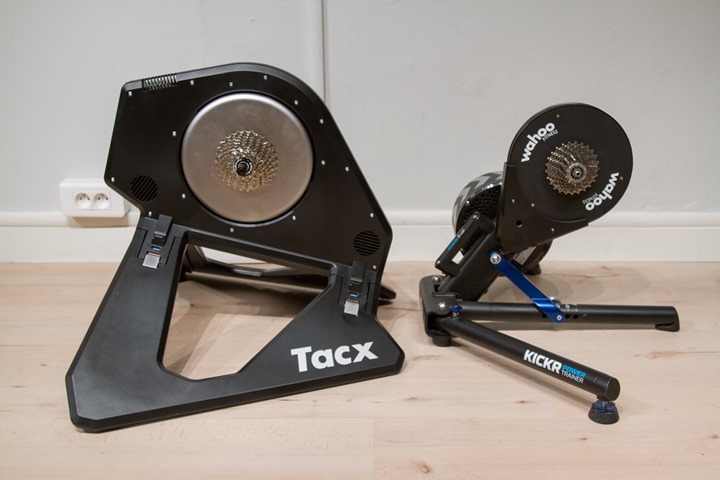
Ashton Instruments made the media rounds at Interbike this year, demonstrating their bottom bracket based system, which they hope to sell for under $500US…in 2016. These MIT students have the foundation for a potential power meter company and product, and were able to demonstrate pieces of it in a hallway (the power meter is the tube piece sitting above, it goes in the hole in the crank arm). They also have riders on one of the local teams testing out basic prototypes of the platform. Note that the solution will be limited to measuring left-only power.
Ultimately while they’ll no doubt be a player to watch in the future, I certainly wouldn’t make any purchasing decisions today or for the foreseeable future based on their product. It’s simply too far out and with far too many unknowns.
Luck Cycling Shoe Power Meter:
This one slipped into the news at Eurobike as the first shoe-based power meter. The power meter sits inside the bottom of the shoe, and will transmit over Bluetooth.
I didn’t have a chance to sit down with these folks, but a few others did, and while they report a December delivery date, those that I’ve talked to that have spent time with the Luck folks don’t think that’s anywhere near an accurate assessment. Of course, I’m happy to be proven wrong. And since Luck is just ‘down the street’ from France (located in Spain), I’m more than happy to go for a test ride and see where things stand. Until then, I wouldn’t make any purchasing decisions based on it.
Non-DFPM Devices:
Finally, we have a few options that use calculations and black magic to determine your power output. These units don’t actually measure your work effort using strain gauges, but instead rely upon other environmental factors. Thus the name of non-Direct Force Power Meters (DFPM).
PowerCal: The PowerTap PowerCal (offered in both ANT+ and Bluetooth Smart) is a heart-rate strap that also transmits power information. It monitors your heart rate and then uses the rate of change to determine power. While many hard-core power meter users are afraid to even glance at the thing, I found that when you started looking at real-world data, it wasn’t actually all that bad. And in fact, it was far more accurate than you’d expect. In general, I’d recommend this for someone that may be buying a heart rate strap anyway and is interested in power (since you’re basically just spending $50 more, it’s about $99 these days). While there are some apps out there that can attempt to do the same thing, none of them re-transmit back over ANT+, so the data isn’t included on your bike computer. Check out the full review for the limitations on where it works well, and where it’s not so hot.
iBike: I haven’t tested out the iBike in a few years now. I do keep abreast of their changes and updates, which are few and far between. While I think there’s some very interesting potential in the aerodynamics aspects when combined with a traditional power meter, I don’t see the price as competitive these days with products like Stages and 4iiii. Further, the head unit hasn’t had a significant overhaul in years and really lacks all of the connectivity of today’s newer units. I don’t at this point have plans to review the iBike, since to be quite frank I see very little demand from readers compared to numerous other products. Ultimately, I have to balance a finite resources like time with so many product reviews to complete.
A quick note about buying used power meters:

Everything in this post is talking about new units whereby you are the original owner. So when I talk about costs there, that’s my baseline. With that in mind, there’s nothing wrong with buying used cycling gear. However, in the case of power meters, I’d caution that accuracy is of the utmost importance. After all, if you’re buying an inaccurate/untrusted power meter, you might as well just send me the cash instead and I’ll send you back random numbers.
Thus if you buy a used power meter my only caution would be to spend the money to have the manufacturer validate/test it, this is especially true if you don’t know the source of the unit.
For example, I’d be less concerned if you had a close friend that used a PowerTap for six months and then decided to swap it out for something else due to changing their rear wheel for a disc. In that case you would know if your friend was having issues with it, and the reason behind the sale (new wheels).
Whereas, if you buy randomly from an unknown person you don’t know the history behind it and I’d be inclined to ensure a trusted 3rd party can complete a test on the device to ensure accuracy. In most cases, the best 3rd party to complete that test is the manufacture itself.
Don’t misunderstand what I’m saying, as I’m not saying you shouldn’t buy used. I’m just saying trust…but verify.
Comparison Chart Tool:
First and foremost, comparison charts ONLY include products that I’m either currently testing, have hands-on time with, or have published a review on. While I know many of you would love me to have other products in there, I simply won’t accept marketing fluff as technical truth. And quite frankly, there’s too much marketing/PR fluff out there to be able to concretely determine whether or not a unit truly has the features it says it has.
You should click the “expand” button at the bottom to see all one gazillion rows. You can build your own power meter comparison chart here. Also, since there are too many columns to fit, you can just tap the “New Window” button instead to see all units.

The charts are updated dynamically, thus if down the road someone updates their prices – you’ll see the most current prices here (even if my text is out of date elsewhere in this post).
So what should you buy?
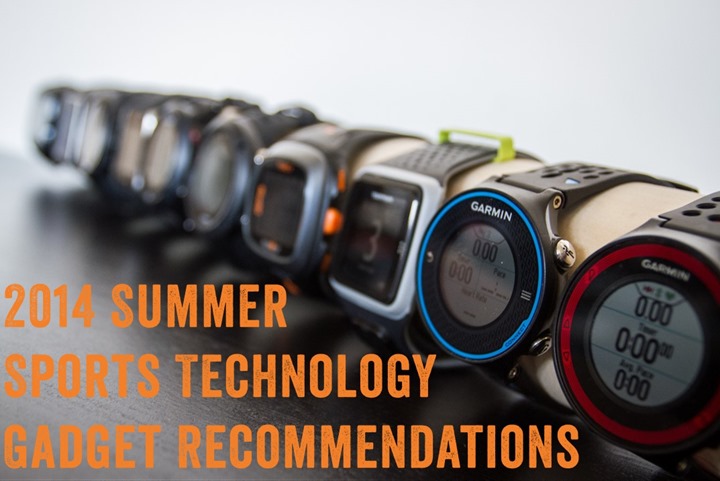
At the end of the day, there’s no single right answer to this question. There’s only ‘best’ answers for a given individual situation. I’ve tried to outline all the major pros and cons of each unit on the market, and in simple language whether or not I’d purchase it (or, purchase it again). The landscape will continue to change. As I noted in the above sections, there’s a raft of at least 3+ power meters on the way before next spring (Northern Hemisphere). Thus, if you aren’t in a hurry to have one before spring, then it quite frankly doesn’t make sense to buy one before then.
I do however think we’ll continue to see pricing shifts, especially among the higher end units. That’s simply inevitable as more players enter the market and fight for your cash. But don’t expect those shifts to occur until 4iiii actually starts shipping. There’s no reason for other companies to charge less when they know they can keep selling at higher prices until 4iiii actually ships.
Finally, last year power meter Guru Alex Simmons put together a similar post around the same timeframe. He also covers some of the older solutions that aren’t made anymore, as well as his unique thoughts on many of the offerings here. Alex is a sharp guy with a lot of good knowledge on power, and his post has been updated for 2014 and is worthwhile reading, as between his and mine I think we may cover questions you have.
Of course, if I haven’t covered something – feel free to plop questions down below. Thanks for reading!











